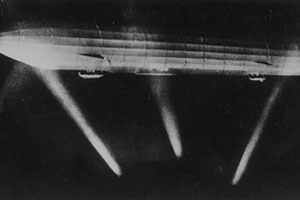
History-Periods
Past eras

From pre-history to today
Choose your period

Periods of History
explore the different eras

During the First World War, London and other cities in the United Kingdom were subject to air raids by German Zeppelin airships and later, by German bomber planes.
The first Zeppelin raid on London occurred on May 31, 1915, and caused little damage. However, the raids became more frequent and more destructive, causing widespread panic and fear among the population.
The Zeppelins were large, hydrogen-filled airships that were difficult to shoot down. They were capable of flying at high altitudes and dropping bombs on the city below. In response to the Zeppelin threat, the government implemented blackouts, whereby all lights were extinguished in the city to make it more difficult for the airships to navigate.
Later in the war, German bombers replaced the Zeppelins as the primary threat to London. The first bombing raid by planes occurred on June 13, 1917, and caused significant damage. The most devastating bombing raid occurred on September 4, 1917, when over 300 German bombers attacked London, killing 162 people and injuring over 400.
The air raids on London and other cities caused significant damage and loss of life, but they also had a significant impact on the war effort. The government was forced to divert resources to air defense, and the fear caused by the raids made it difficult to maintain morale among the population. However, the raids also highlighted the potential of air power, and paved the way for the development of air defense systems and the use of bombers in future wars.
The air raids on London during the First World War caused fear and panic among the population. The government responded by implementing a number of measures to protect the public and to counter the threat of the raids.
One of the most significant responses was the implementation of blackout regulations. In order to make it more difficult for the German airships and planes to navigate and target the city, all lights were turned off in London and other cities at night. This made it difficult for pilots to locate their targets, and it also made it harder for the Germans to navigate their aircraft.
The government also established a number of air defense systems, including anti-aircraft guns and fighter planes, to shoot down enemy aircraft. The Royal Flying Corps (which later became the Royal Air Force) was created to defend against the air raids.
In addition to these measures, the government also encouraged the public to support the war effort and to remain calm in the face of the attacks. This was seen as important to maintain morale and to prevent the Germans from achieving a psychological victory.
The Germans continued to develop their air raid strategy and conducted more attacks on London and other cities during the First World War. After the initial Zeppelin raids, they switched to using Gotha and Friedrichshafen bomber planes, which were faster and more heavily armed than the airships.
The German bombing campaign intensified in 1917, and several major air raids were conducted on London, including the raid on September 4, 1917, which I mentioned earlier. This raid, which involved over 300 bombers, caused significant damage and loss of life and was one of the most destructive air raids of the war.
In addition to these attacks, the Germans also continued to develop their air technology, including more advanced bombers and fighter planes. The development of air power during the First World War laid the foundation for the use of strategic bombing in future conflicts.
It's worth noting that the German air raid campaign was not as effective as they had hoped, as their planes suffered significant losses from anti-aircraft fire and fighter planes. Additionally, the British government was able to implement effective countermeasures, such as the blackout and air defense systems, to mitigate the impact of the raids. Nevertheless, the German air raids on London and other cities during the First World War represented a significant development in the history of warfare, and set the stage for the use of air power in future conflicts.
This section needs to be completed
If you have a suggestion regarding additional topics you would like to see included - please let us know
Reference: Article by Greg Scott (Staff Historian), 2024
Tour Reviews
History Attractions
Submit Tour Suggestions
2024 Departures
Spotlight Tours
Events and anniversaries

All content and images are protected by copyright to Access History